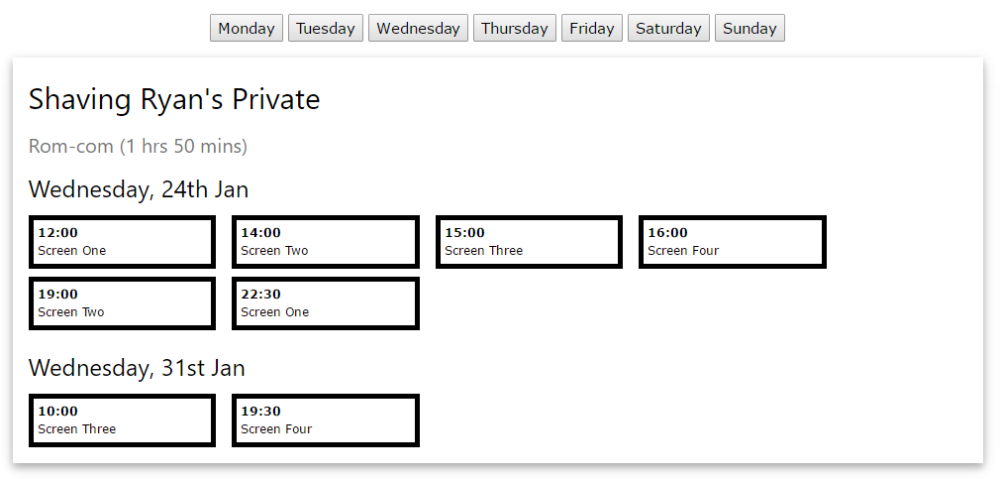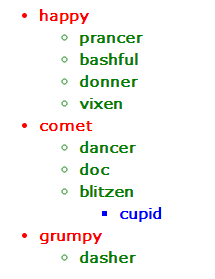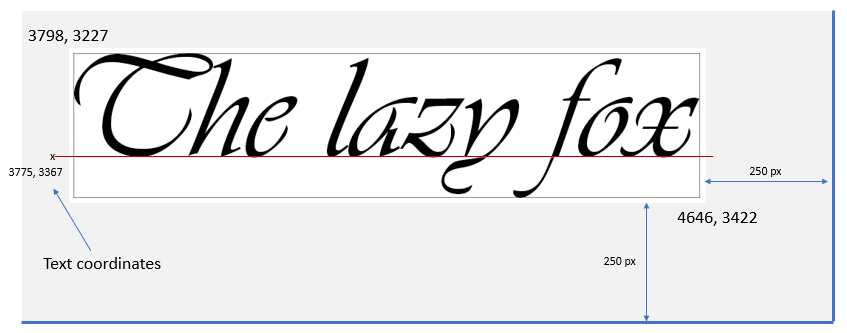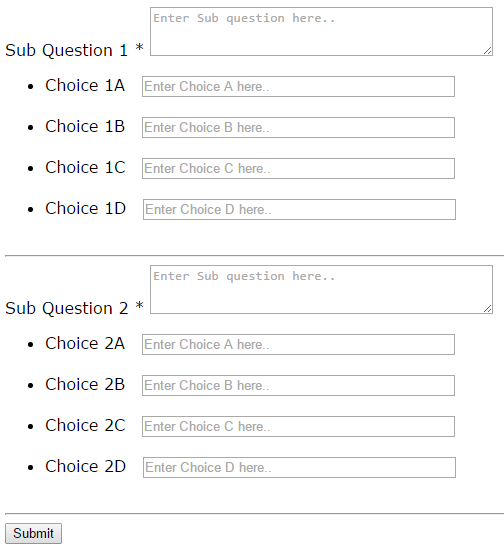Leaderboard
Popular Content
Showing content with the highest reputation since 09/23/2012 in Posts
-
Something like this? CODE <?php include 'db_inc.php'; // YOUR CONNECTION $pdo = pdoConnect('movies'); // CODE GOES HERE ################################################################################ ## PROCESS AJAX REQUESTS ################################################################################ if (isset($_GET['ajax'])) { $res = $pdo->prepare("SELECT m.id as movie_id , m.title , m.image , g.description as genre , CONCAT(m.running_time DIV 60, ' hrs ', m.running_time % 60, ' mins') as running_time , date_format(sg.screen_on, '%W, %D %b') as date , s.name as screen_num , TIME_FORMAT(sg.screen_at, '%H:%i') as start_time FROM screening sg JOIN screen s ON sg.screen_id = s.id JOIN movie m ON sg.movie_id = m.id JOIN genre g ON g.id = m.genre WHERE dayname(screen_on) = :day ORDER BY movie_id, screen_on, sg.screen_at "); $res->execute([ 'day' => $_GET['day'] ]); $data = []; # # Put data into an array with same structure a required output # - array of movies, each movie having arrays of screenings # foreach ($res as $r) { if (!isset($data[$r['movie_id']])) { $data[$r['movie_id']] = [ 'title' => $r['title'], 'image' => $r['image'], 'genre' => $r['genre'], 'runtime' => $r['running_time'], 'screenings' => [] ]; } $data[$r['movie_id']]['screenings'][$r['date']][] = ['start' => $r['start_time'], 'sno' => $r['screen_num'] ]; } exit(json_encode($data)); } ?> <!DOCTYPE html> <html lang="en"> <head> <meta name="generator" content="PhpED 12.0 (Build 12010, 64bit)"> <meta name="viewport" content="width=device-width, initial-scale=1.0"> <title>olumide</title> <link rel="stylesheet" href="https://www.w3schools.com/w3css/4/w3.css"> <link rel="stylesheet" href="https://cdnjs.cloudflare.com/ajax/libs/font-awesome/6.2.1/css/all.min.css"> <script src="https://code.jquery.com/jquery-3.6.0.min.js"></script> <script type='text/javascript'> function showScreenings(day) { $("#movie-listings").html("") $.get( "", {"ajax":1, "day":day}, function(resp) { $.each(resp, function(mid, mdata) { let title = `<h2>${mdata.title}</h2><h4 class='w3-text-gray'>${mdata.genre} (${mdata.runtime})</h4>` $("#movie-listings").append(title) $.each(mdata.screenings, function(dt, ddata) { let datesub = `<h3>${dt}</h3>` $("#movie-listings").append(datesub) $("#movie-listings").append("<div class='screenings'") $.each(ddata, function(k, sdata) { let scr = `<div class='screening'><b>${sdata.start}</b><br>${sdata.sno}</div>` $("#movie-listings").append(scr) }) $("#movie-listings").append("</div>") }) }) }, "JSON" ) } </script> <style type='text/css'> .days { padding: 16px; text-align: center; } .screening { width : 20%; display: inline-block; margin-right: 16px; margin-bottom: 8px; padding: 4px; border: 5px solid black; font-size: 9pt; } </style> </head> <body> <nav class="days"> <button onclick="showScreenings('Monday')">Monday</button> <button onclick="showScreenings('Tuesday')">Tuesday</button> <button onclick="showScreenings('Wednesday')">Wednesday</button> <button onclick="showScreenings('Thursday')">Thursday</button> <button onclick="showScreenings('Friday')">Friday</button> <button onclick="showScreenings('Saturday')">Saturday</button> <button onclick="showScreenings('Sunday')">Sunday</button> </nav> <div id='movie-listings'class='w3-content w3-padding w3-card-4'> <!-- LISTINGS GO HERE --> </div> </body> </html>3 points
-
I guess you don't understand that phpfreaks is a free site, with expert help provided by volunteers. Given the fact that everyone is donating their time and expertise to try and help people like yourself, the argument that you host a free site with source code you got from somewhere else for free, means you shouldn't ever have to learn anything (which can be learned in a few hours) will not get you much sympathy here.3 points
-
By far the best the best way is to fix whatever they are warning you about.3 points
-
@HawkeNN I want to clarify some things for you. Most code that was written for PHP 7.x will still run fine under php 8. For the most part PHP 8 added new features. There are "Breaking Changes" that were made, listed here: https://www.php.net/manual/en/migration80.incompatible.php but it is unlikely that is the problem with your code from some of the errors I saw listed. For example, the "headers already sent" error is a common one and has been around since php 3 at least. It has to do with code that sends output to the browser (as in the case of a script that intermixes HTML and php) and then tries to set HTTP header values. At that point, the HTTP request has already been sent with whatever headers it had, and it's too late to add or modify them. PHP session use is one function that sets header values because it sets a cookie. Some of the advice that you got is related to common techniques for trying to solve the issue. Equally important is your hosting configuration for PHP. Changes to the configuration of PHP from a version upgrade, can turn on settings that might have been off previously, or warnings being emitted that weren't before. This can then trigger output which also causes the "headers already sent" message. I suspect that this is part of your problem here, and really requires some debugging of your hosting setup. This was already brought up to you, in that there will be a php.ini (and often other assorted xyz.ini files that are included by the main php.ini) where settings can be made or changed to re-configure php. In conclusion, this is a PHP developer forum. From looking at this thread, you aren't likely to have a good outcome here, because you aren't a php developer. My sincere advice is to just find yourself a developer (this forum is chock full of them) you can pay a fee to, in order to resolve your issues and get your site working again. We have established that the code is bad, and that there is likely a few different things going on that are somewhere between the configuration of your server to possible improvements to the code you have. In other words, this is a problem for an experienced developer that requires debugging. I probably shouldn't say this, but my knee jerk reaction is that getting your code to work is not that big of a job, but looking at a thread like this is frustrating to read, because in my experience it is not going anywhere. There isn't any long term value to it for our forum, and you are not going to become an active member of the forum, nor learn PHP development, so there is nothing in it for us, or the community at large.3 points
-
With a couple of db tables like this Table: user Table: role +---------+----------+--------+ +---------+---------------+-----------+------------+ | user_id | username | points | | role_id | role_name | point_min | points_max | +---------+----------+--------+ +---------+---------------+-----------+------------+ | 1 | John | 66 | | 5 | - | 0 | 100 | | 2 | Paul | 101 | | 6 | Contributor | 101 | 1000 | | 3 | George | 3000 | | 7 | Author | 1001 | 10000 | | 4 | Ringo | 200000 | | 8 | Editor | 10001 | 100000 | +---------+----------+--------+ | 9 | Administrator | 100001 | 999999999 | +---------+---------------+-----------+------------+ Then a simple query SELECT username , rolename FROM user u JOIN role r ON u.points BETWEEN r.points_min AND r.points_max; does the job for you +----------+---------------+ | username | rolename | +----------+---------------+ | John | - | | Paul | Contributor | | George | Author | | Ringo | Administrator | +----------+---------------+3 points
-
Use DATE type columns for your dates, not varchar. Have your leaving dates either a valid date or NULL. SELECT eemp_id , fname , lname , AVG(timestampdiff(MONTH, joining_date, coalesce(leaving_date, curdate()))) as av_mths FROM employee_details ed JOIN employee e ON e.empid = ed.eemp_id GROUP BY eemp_id HAVING av_mths >= 36;3 points
-
If you are outputting an image from a DB blob field, then here's an example... // EMULATE DATA FROM THE DATABASE $type = 'image/png'; $comments = 'Lorem ipsum dolor sit amet, consectetuer adipiscing elit. Maecenas porttitor congue massa. Fusce posuere, magna sed pulvinar ultricies, purus lectus malesuada libero, sit amet commodo magna eros quis urna.'; $image_data = file_get_contents('images/snowman.PNG'); // OUTPUT THE DATA echo "<div style='width:396;'> <img src='data:{$type};base64," . base64_encode( $image_data ) . "' width='394' height='393'> <p>$comments</p> "; RESULT3 points
-
Don't use "SELECT * ". Specify the columns you want. This makes it easier for others, like me, to understand what is in the table and what the query is doing. Indent your code to show the nested structure of loops etc. If you had done those I might have given this problem more than a cursory glance. So you'll have to settle for a generic example of using a recursive function to give an indented list of parent/child elements. Also, Don't run queries inside loops. Use JOINs to get all the data in a single query THE DATA TABLE: category +----+---------+--------+ | id | name | parent | +----+---------+--------+ | 1 | happy | 0 | | 2 | comet | 0 | | 3 | grumpy | 0 | | 4 | prancer | 1 | | 5 | bashful | 1 | | 6 | dancer | 2 | | 7 | doc | 2 | | 8 | blitzen | 2 | | 9 | dasher | 3 | | 10 | donner | 1 | | 11 | vixen | 1 | | 12 | cupid | 8 | +----+---------+--------+ THE OUTPUT THE CODE <?php $sql = "SELECT id, name, parent FROM category"; $res = $db->query($sql); // // store arrays of items for each parent in an array // while (list($id, $name, $parent) = $res->fetch(PDO::FETCH_NUM)) { $data[$parent][] = array('id'=>$id, 'name'=>$name); } /** * recursive function to print a category then its child categories * * @param array $arr category data * @param int $parent parent category * @param int $level hierarchy level */ function displayHierarchy(&$arr, $parent, $level=0) { if (isset($arr[$parent])) { echo "<ul>\n"; foreach($arr[$parent] as $rec) { echo "<li class='li$level'>{$rec['name']}\n"; if (isset($arr[$rec['id']])) displayHierarchy($arr, $rec['id'], $level+1); echo "</li>\n"; } echo "</ul>\n"; } } ?> <!DOCTYPE html> <html> <head> <meta http-equiv="Content-Type" content="text/html; charset=utf-8"> <title>Example</title> <link rel="stylesheet" href="https://www.w3schools.com/w3css/4/w3.css"> <script src="https://ajax.googleapis.com/ajax/libs/jquery/3.3.1/jquery.min.js"></script> <script type="text/javascript"> </script> <style type="text/css"> body { font-family: verdana,sans-serif; font-size: 11pt; padding: 50px; } li { font-weight: 600;} .li0 { color: red; } .li1 { color: green; } .li2 { color: blue; } </style> </head> <body> <?php displayHierarchy($data, 0); ?> </body> </html>3 points
-
Too many people are obsessed with "filtering" bad inputs. You don't have to "filter" anything. You don't have to remove HTML tags. You don't have to remove SQL keywords. You don't have to strip quotes or backslashes. All you have to do is make sure that whatever the user typed doesn't screw around with what you're trying to do. Want to put it into HTML? Make sure it doesn't screw around with your HTML. Want to put it into SQL? Make sure it doesn't screw around with your SQL. Want to send it in JSON? Make sure it doesn't screw around with your JSON. And every single one of those situations has a simple, single best-practice solution: HTML? Use htmlspecialchars with ENT_QUOTES* and the correct charset. SQL? Use prepared statements. JSON? Use json_encode. That's it. No filter_vars or filter_inputs, no strip_tags, no regular expressions, nothing stupid like that. User wants to look cool and type <script> tags into their forum post? Go ahead and let them, because it'll just show up as plain and simple text. Like it just did now. * Only actually required if you are putting the input into an single quote-delimited tag attribute. Using double quotes for your attributes? Not outputting into an HTML tag? Then you don't technically need ENT_QUOTES.3 points
-
3 points
-
People still use StackOverflow? That's only half a joke. Their community has always been toxic to newcomers and there's so much emphasis on correctness that anything less than perfect is unacceptable. And there's the hostility towards any form of discussion about what is right that I always mention when this subject comes up. SO is good when you're looking for a precise answer to a specific question, but it's terrible for actually asking the questions, or trying to weigh in as a new person with different answers. But I am glad they dethroned Expert Sex Change in search results. edit: If Your Common Sense/shrapnelcol came across this thread and decided they wanted to join our forum...3 points
-
A few notes about text bounding boxes which, I hope, will help in precise placement of your text. Suppose I have the text string "The lazy fox" which I want to display using 150pt Vivaldi . My image is 4896 x 3672 and I want the text placed at the bottom right but 250 pixels from the edges of the image. $box = imagettfbbox(150,0,'c:/windows/fonts/vivaldii.ttf','The lazy fox'); gives this array of coordinates of the four corners $box = Array ( [0] => 23 [1] => 55 [2] => 871 [3] => 55 [4] => 871 [5] => -140 [6] => 23 [7] => -140 ) You may wonder why it can't just give a rectangle from (0,0) to (width, height) to make sizing simple, but there is extra information to be extracted from the array Text width = (871 - 23) = 848 Text height = 55 - (-140) = 195 The baseline will be 140px from the top The text is offset 23 px to the right. My text, therefore, will be in a rectangle 848 x 195 positioned 250 px from right and bottom edges. The top left x coord of the rectangle will be (4896 - 250 - 848) = 3798 and top left y coord will be (3672 - 250 - 195) = 3227. However, to land the text precisely into this area we position it on the baseline and at the required x offset, ie (3798 - 23 , 3227 + 140) = (3775, 3367). I use a simple custom function to assist with this process function metrics($font, $fsize, $str) { $box = imagettfbbox($fsize, 0, $font, $str); $ht = abs($box[5] - $box[1]); $wd = abs($box[4] - $box[0]); $base = -$box[5]; $tx = -$box[0]; return [ 'width' => $wd, 'height' => $ht, 'ascent' => $base, 'offsetx' => $tx ]; } $box = metrics ('c:/windows/fonts/vivaldii.ttf', 150, 'The lazy fox'); $box = Array ( [width] => 848 [height] => 195 [ascent] => 140 [offsetx] => -23 )3 points
-
Don't use $GLOBALS. Forget it exists. There is never a good reason to use it. Pretend you never saw it.3 points
-
+----------------+ +----------------+ | Make sure to |---+ +------->| (e.g. Courier) | +----------------+ | | +----------------+ | | | | +----------+ | | +->| use a |---+ | | +----------------+ +----------+ | | +------->| and use spaces | | | +----------------+ | +----------------+ | | +--->| monospace font |-----+ | +----------------+ | +----------+ | | not tabs |<----------+ +----------+ | +--------------------------------------------------------------------------+ | V +---------------+ | It also helps | +---------------+ | | | +-------------------+ +-------------------+ +------------------------>| if you sometimes |---------------------->| switch between | +-------------------+ +-------------------+ | | +-----------------+-----------------+ | | | | +-------------------+ +-------------------+ | overtype | | insert | +-------------------+ +-------------------+ | | | | | +----------+ | +----------=>| modes |<----------+ +----------+3 points
-
the file system path/filename must be to where the file is located on the disk, either using a relative path (relative to the file with the include/require starting in it) or an absolute path. a leading / refers to the root of the current disk, which is doubtful where that file is located, and which will be producing a php error about a non-existent path/file. you must get php to help you by reporting and displaying all the errors it detects. you can temporarily set php's error_reporting/display_errors in your code (you will want to remove the settings when you are done learning, developing, and debugging). you can add the following immediately after the first opening <?php tag in the main file - ini_set('display_errors', '1'); error_reporting(-1);2 points
-
Judicious application of array key names can greatly increase the efficiency and simplicity of your code. Consider this simplified version of the questions/options form code <form method='post' > <?php for ($qno=1; $qno<=2; $qno++) { echo <<<HTML <label> Sub Question $qno <span class="req">*</span> <textarea cols="46" rows="3" name="Q[$qno][question]" placeholder="Enter Sub question here.."></textarea> </label> <ul> HTML; for ($opt='A'; $opt<='D'; $opt++) { echo <<<HTML <li>Choice $qno$opt (text) <input type='text' name="Q[$qno][opts][$opt]" placeholder="Enter Choice A here.." size='40'> </li><br><br>\n HTML; } echo "</ul><hr>\n"; } ?> <input type='submit'> </form> producing... When the form is submitted, the POST array is like this... Array ( [Q] => Array ( [1] => Array ( [question] => aaaaaaaaaaaaaaaaaaaaaaaaaaa [opts] => Array ( [A] => aa [B] => bb [C] => cc [D] => dd ) ) [2] => Array ( [question] => bbbbbbbbbbbbbbbbbbbbbbbbb [opts] => Array ( [A] => ww [B] => xx [C] => yy [D] => zz ) ) ) ) Now you can easily iterate through the array to write the questions/options to you database foreach ( $_POST['Q'] as $qno => $qdata ) { write $qno and $qdata['question'] to question table save last insert id as $qid foreach ( $qdata['opts'] as $ono => $choice ) { write $qid, $ono, $choice to choice table } } Job Done.2 points
-
2 points
-
You've done the hard work already. Instead of calculating the product, store the selected array. <?php $primes = array(2, 3, 5, 7, 11, 13, 17, 19, 23); $combos = []; function getAllCombinations($arr, $n, &$combos, $selected = array(), $startIndex = 0) { if ($n == 0) { $combos[] = $selected; // $product = 1; // foreach ($selected as $prime) { // $pr[] = $prime; // $product *= $prime; // $pr[] = $prime; // } // echo "Product: $product\n"; return; } for ($i = $startIndex; $i < count($arr); $i++) { $selected[] = $arr[$i]; getAllCombinations($arr, $n - 1, $combos, $selected, $i + 1); array_pop($selected); // Backtrack and remove the element for next iteration } } getAllCombinations($primes, 4, $combos); echo '<pre>'; foreach ($combos as $com) { printf("%-35s = %5d<br>", join(' × ', $com), array_product($com)); // output numbers and product } ?> giving 2 × 3 × 5 × 7 = 210 2 × 3 × 5 × 11 = 330 2 × 3 × 5 × 13 = 390 2 × 3 × 5 × 17 = 510 2 × 3 × 5 × 19 = 570 2 × 3 × 5 × 23 = 690 2 × 3 × 7 × 11 = 462 2 × 3 × 7 × 13 = 546 2 × 3 × 7 × 17 = 714 2 × 3 × 7 × 19 = 798 2 × 3 × 7 × 23 = 966 2 × 3 × 11 × 13 = 858 2 × 3 × 11 × 17 = 1122 2 × 3 × 11 × 19 = 1254 2 × 3 × 11 × 23 = 1518 2 × 3 × 13 × 17 = 1326 2 × 3 × 13 × 19 = 1482 2 × 3 × 13 × 23 = 1794 2 × 3 × 17 × 19 = 1938 2 × 3 × 17 × 23 = 2346 2 × 3 × 19 × 23 = 2622 2 × 5 × 7 × 11 = 770 2 × 5 × 7 × 13 = 910 . . 5 × 17 × 19 × 23 = 37145 7 × 11 × 13 × 17 = 17017 7 × 11 × 13 × 19 = 19019 7 × 11 × 13 × 23 = 23023 7 × 11 × 17 × 19 = 24871 7 × 11 × 17 × 23 = 30107 7 × 11 × 19 × 23 = 33649 7 × 13 × 17 × 19 = 29393 7 × 13 × 17 × 23 = 35581 7 × 13 × 19 × 23 = 39767 7 × 17 × 19 × 23 = 52003 11 × 13 × 17 × 19 = 46189 11 × 13 × 17 × 23 = 55913 11 × 13 × 19 × 23 = 62491 11 × 17 × 19 × 23 = 81719 13 × 17 × 19 × 23 = 965772 points
-
Sorry to see your valuable time was wasted by Barand providing you free professional consulting, custom built code and hand holding. 😣2 points
-
Once again we have no idea what the data you are processing looks like. Post the output from this code... echo '<pre>' . var_export($data, 1) . '</pre>';2 points
-
the code is doing exactly what it was written to do, build a <tr><td>num</td></tr> for each number. if you want to produce a single <tr></tr>, you would need to add the opening <tr> before the start of the looping and add the closing </tr> after the end of the looping.2 points
-
@gizmola With my model you would need to bring the ticket date into the equation SELECT s.id, s.row, s.seat_no FROM seat s LEFT JOIN booking b ON b.seat_id = s.id AND b.screening_id = 35 AND B.ticket_date = '2024-01-03' -- also required WHERE s.screen_id = 1 AND b.id IS NULL; As it is, a screening record states that the movie will be screened at time T each day between X and Y. On reflection, although requiring more rows, it would be better to have a screening record for every individual screening, giving... then your query would work as it is. Alternatively, to get vacant seats for a screening (and only requiring the screening id as input - if the screening id is known then the screen id is also known) you could SELECT s.id, s.row, s.seat_no FROM screening sg JOIN seat s ON sg.screen_id = s.screen_id LEFT JOIN booking b ON b.screening_id = sg.id AND b.seat_id = s.id WHERE sg.id = 35 AND b.id IS NULL2 points
-
2 points
-
2 points
-
Easier with PDO $stmt = $pdo->prepare($sql); $stmt->execute($SearchValues);2 points
-
first of all you should use an unique index for email and I don't understand the also having for username (though that too). Though I now can see both...tired. Second take a look at this $sql = "SELECT * FROM register WHERE username:username AND email:email"; See anything missing? I give you a hint it's between username :username and also email :email. Here's a good link https://phpdelusions.net/pdo and I even still use it from time to time.2 points
-
So just to say it, the on event handler is accepting a callback function to run when there is a "play" event. A simpler solution would be to just have a function defined there, that the callback would run, or to define a function globally and pass the name of the function. However, @Kicken coded this function to return an anonymous function. It helps to focus in on return statements in code like this. If you notice the requestSent variable is declared outside the function declaration that does the work. This creates a "closure" (or takes advantage of javascript closure) depending on how you want to think about it. It makes the variable requestSent available to the inner function that is being returned, and this variable will continue to exist in the browser's memory associated with the window/page, until such a time as a new request is made that causes new html/javascript/css to be loaded. An alternative would be to declare requestSent globally and use that, but he gave you something more sophisticated -- a function that returns a function and takes advantage of a variable that is only visible to the anonymous function, and yet is available to the anonymous function across executions. Each time the callback is run, this could be either for the same song or a different song, so inside the function, there is a jQuery call to find the id of the button. let a_id = $(this).attr("id") It's good to think about why this is declared inside the function and how that works. Since this handler can be called for any song, the $(this) resolves in this situation as the song that is being played. Thus the a_id gets set each time there's a play event, and then gets the html id attribute. I added code to push the value onto the requestSent array, which again, since it's part of the closure for the anonymous function, survives across plays. I used Array.includes() to check if the song id already exists in requestSent. If not, I update requestSent with requestSent.push(a_id) and the ajax runs, passing a_id. The ajax is also being done using the jQuery library. The final question you should probably be asking is: if this is a function that returns a function, then how is it, that the callback, which requires a function to run, gets the actual function it needs. A function that returns a function is not a callback. The answer is that again Kicken used an IFFE here. What is actually being passed is a function that is immediately executed. You can see this because after the function definition function () { ... } It is immediately followed by the parens ie. () which causes javascript to execute the function. function () { ... }() So this code works because the function that returns a function, is run immediately, giving the callback parameter what it wants ... a function to run when a play event occurs. The function is anonymous and only bound to the event handler for play events, which also keeps global scope from being cluttered with a symbol table entry for a function that is only needed for the callback. The benefit of doing it this way is that he did not need to utilize a global variable, since closure takes care of this for you. This type of code is favored in many situations, since you don't have a slew of global variables floating around. Nothing outside the callback function can see or modify the requestSent array -- yet it is essentially a private environment that the callback uses. As I said previously -- advanced javascript stuff, that can be confusing if you are still learning javascript. Hope this helps -- using those terms (IFFE, javascript closure, js anonymous function, js callbacks, js this) will lead you to an enormous amount of additional material if you need to explore them further.2 points
-
I think I might have guessed right regarding an access policy. How much "customization" does each resource need regarding its access? I would assume not much, and that they all typically pick from a small handful of possibilities. If so then you have access policies, a resource uses an access policy, every user has something to consume policies in a similar design, then you manage access through those secondary objects. user <-> permission policy <-> access policy <-> resource The principle here is that a resource does not try to decide how and where it can be used - it has a policy which manages that. And a user doesn't decide how and what it can use - it has permissions that decide. Consider a roller coaster ride. They'll have a sign saying "you must be this tall to ride" and a person who enforces that; the roller coaster is the resource and the sign is the access policy. When someone wants to ride, they present themselves; they are a user and their permissions are their physical appearance (ie. height). The person who enforces the height requirement would then be the code used to implement the system - someone who understands the access policy, the permissions, and how to evaluate the two together.2 points
-
or... $res = $pdo->query("SELECT `option`, total FROM vote"); $data = $res->fetchAll(); $votes_cast = array_sum( array_column($data, 'total') ); foreach ($data as $r) { printf ("%s has %d votes (%0.1f %%)<br>", $r['option'], $r['total'], $r['total']*100/$votes_cast); }2 points
-
Depending on what it is you're trying to do with the data, there are several ways to change a field. You can set up an accessor or mutator or use a query scope, for instance. Query scope sounds like what you're looking for, although should worse comes to worst you could just write a trait and use it on your model instances where needed.2 points
-
First only returns a single item, so there's no point in putting it in a collection. The collection is for methods that might return several items.2 points
-
Example $arr = [ [ 'A', 'Jan. 22, 22'], [ 'B', 'Dec. 25, 21'], [ 'C', 'Feb. 22, 22'], [ 'D', 'Jan. 2, 22'] ]; usort($arr, function($a, $b) { $da = DateTime::createFromFormat('M. j, y', $a[1]); $db = DateTime::createFromFormat('M. j, y', $b[1]); return $db <=> $da; }); echo '<pre>' . print_r($arr, 1) . '</pre>'; outputs Array ( [0] => Array ( [0] => C [1] => Feb. 22 22 ) [1] => Array ( [0] => A [1] => Jan. 22 22 ) [2] => Array ( [0] => D [1] => Jan. 2 22 ) [3] => Array ( [0] => B [1] => Dec. 25 21 ) )2 points
-
Probably not what you really want, but it is what you asked for: $midPt = floor(strlen($content)/2); $file["content"] = substr($content, 0, $midPt) . $context['user']['id'] . substr($content, $midPt);2 points
-
Apparently the DateInterval class supports milliseconds, but the default method does not support it as an input value. You need to instead use the createFromDateString class of that method // convert your date to DateTime object $date = '10:00:00.500000'; $dt = new DateTime($date); // convert your period to $interval = '00:25:10.300000'; //Extract time parts list($hours, $minutes, $totalSeconds) = explode(':', $interval); list($wholeSeconds, $milliSeconds) = explode('.', $totalSeconds); //Create interval with milliseconds $intervalString = "{$hours} hours + {$minutes} minutes + {$wholeSeconds} seconds + {$milliSeconds} microseconds"; $interval = DateInterval::createFromDateString($intervalString); // Add interval to date $dt->add($interval);// Format date as you needecho $dt->format('H:i:s'); echo $dt->format('Y-m-d\TH:i:s.u'); //Output: 2021-11-12T10:25:10.8000002 points
-
Or avoid the concatenation which is usually the biggest source of error (and the query string needs an "=") echo "<a href='icerik.php?icerik={$goster['icerik_id']}'>{$goster['baslik']}</a>";2 points
-
While PHPStorm is subscription based, it's pretty good in my opinion and for an IDE it has helped my PHP skills a lot. It makes suggestions on how to write the code in a better way that I would never have thought of and makes syntax errors easy to resolve. I am not affiliated with JetBrains as I just like using their developer tools as it simplifies my coding a lot.2 points
-
This fails $j = "{'admin': 1, 'moderator': 1}" ; $a = json_decode($j, 1); echo '<pre> a ' . print_r($a, 1) . '</pre>'; This works $j = '{"admin": 1, "moderator": 1}' ; $b = json_decode($j, 1); echo '<pre> b ' . print_r($b, 1) . '</pre>'; Note the quotes in the JSON string.2 points
-
If you want to use silly names like that with the "." at the end then you need the column name inside backticks. SELECT `KNr.` FROM .... From MySQL manual2 points
-
Hello everyone, I'm very new to this site. I'm here to learn how to code in PHP as I once did. I'm very raw at tho, and I'm looking to start back up in it again. So again, hello everyone and remember I'm new. So any dummy questions I made ask, please bear with me. I would like to start my own web site for my own purpose. Something very small and for my needs. And to top it all off, I'm going to run it on a Raspberry Pi from my home. This is should be a fun trip. Thanks Sincerely Dan2 points
-
Do you mean something like this? <?php // get the "name" headings that you need for the columns // and also use them as keys in a "template" array // $res = $db->query("SELECT DISTINCT name FROM dataset ORDER BY name "); $names = $res->fetchAll(); $heads = array_column($names, 'name'); $temp = array_fill_keys($heads, ''); $table_header = "<tr><td></td><td class='thead'>Result</td><td class='thead'>" . join("</td><td class='thead'>", $heads) . "</td></tr>\n"; // now get the data // store in an array by "id" // witd subarrays for each name $res = $db->query("SELECT id , edate , result , name , nos FROM maintab m JOIN dataset d ON m.id = d.mid ORDER BY id "); $data = []; foreach ($res as $r) { if (!isset($data[$r['id']])) { $data[$r['id']] = [ 'edate' => $r['edate'], 'result' => $r['result'], 'names' => $temp // the template array from earlier ]; } $data[$r['id']]['names'][$r['name']] = $r['nos']; // put value in tempate array } // now we simply output data array into html table rows $tdata = ''; foreach ($data as $row) { $tdata .= "<tr><td>{$row['edate']}</td><td>{$row['result']}</td><td>" . join('</td><td>', $row['names']) . "</td></tr>\n"; } ?> <html> <head> <title>Example</title> <style type='text/css'> td { padding: 4px 10px; } .thead { font-weight: 600; border-top: 1px solid gray; border-bottom: 1px solid gray; } </style> </head> <body> <table> <?= $table_header ?> <?= $tdata ?> </table> </body> </html> OUTPUT [edit] PS Sorry about the data typo. That's what happens when people post pictures instead of copyable text.2 points
-
Sort the array first. Assuming you start with ... $options = [ [ 'type' => 'Visual disability', 'name' => 'Audio-described cut-scenes' ], [ 'type' => 'Visual disability', 'name' => 'Highlighted path to follow' ], [ 'type' => 'Physical disability', 'name' => 'Sensitivity settings for all the controls' ], [ 'type' => 'Visual disability', 'name' => 'Screen readers on menus' ], [ 'type' => 'Visual disability', 'name' => 'Slow down the game speed' ], ]; then ... # # Sort the array by type (descending) # usort($options, function($a, $b) { return $b['type'] <=> $a['type']; }); # # process the array # $prev_type = ''; // store previous type echo "<ul>\n"; foreach ($options as $opt) { if ($opt['type'] != $prev_type) { // is this a new type? if ($prev_type != '') { // was there a previous one? echo "</ul>\n</li>\n"; // if so, close it } echo "<li>{$opt['type']}\n<ul>\n"; $prev_type = $opt['type']; // store as previous value } echo "<li>{$opt['name']}</li>\n"; } // close last group echo "</ul>\n</li>\n"; // close whole list echo "</ul>\n"; giving ... <ul> <li>Visual disability <ul> <li>Audio-described cut-scenes</li> <li>Highlighted path to follow</li> <li>Screen readers on menus</li> <li>Slow down the game speed</li> </ul> </li> <li>Physical disability <ul> <li>Sensitivity settings for all the controls</li> </ul> </li> </ul> An alternative approach is to reorganise the array using subarrays for each type... $options = [ 'Visual disability' => [ 'Audio-described cut-scenes', 'Highlighted path to follow', 'Screen readers on menus', 'Slow down the game speed' ], 'Physical disability' => [ 'Sensitivity settings for all the controls' ] ]; then use two nested foreach() loops.2 points
-
That's why I laid it out the way I did with the comments - so it would be easy for you get the separate feet/inches values if you still wanted to go that way. [edit] Look more closely at my code - you require two substring_index()s to extract the inches. The inner to get the string before the final " and the outer one to get the string after the ' SET feet = substring_index(@height, '\'', 1) * 12 , inches = substring_index(substring_index(@height, '"', 1), '\'', -1)2 points
-
NOTE: both instances of $db->query(..) in the above post should be $db->prepare(..)2 points
-
Short answer: it's safe. Longer answer: it's as safe as any other PHP file on your server. It's a common practice to put this script, or at least a script that defines variables/constants with database credentials, in a PHP file that is not located inside the web root (eg, outside of your public_html or www or whatever directory that your site is based in) because if it's not an actual page then it really shouldn't be in the root; this practice is easy to achieve when you get larger sites that have a single public_html/index.php that runs an "application" or some similar concept whose files are all outside the root.2 points
-
I created an extra table to define which category the values were in mysql> select * from catval; +-----+------+ | val | cat | +-----+------+ | 1 | 4 | | 2 | 4 | | 3 | 4 | | 4 | 4 | | 5 | 3 | | 6 | 3 | | 7 | 2 | | 8 | 2 | | 9 | 1 | | 10 | 1 | +-----+------+ then $sql = "SELECT a.cat as cata , b.cat as catb FROM datatb d JOIN catval a ON d.grpa = a.val JOIN catval b ON d.grpb = b.val "; $result = $db->query($sql); //categories $cat = [ 4 => ['name'=>'1:4', 'recs'=>[]], 3 => ['name'=>'5:6', 'recs'=>[]], 2 => ['name'=>'7:8', 'recs'=>[]], 1 => ['name'=>'9:10','recs'=>[]] ]; $n = 0; while ($row = $result->fetch_assoc()) { $cat[$row['cata']]['recs'][$n][] = $row['cata']; $cat[$row['catb']]['recs'][$n][] = $row['catb']; $n++; } // the output echo "<table border='1' style='width:500px; border-collapse:collapse;'>"; foreach ($cat as $c) { echo "<tr><th>{$c['name']}</th>"; for ($i=0; $i<$n; $i++) { echo '<td style="text-align:center;">' . (isset($c['recs'][$i]) ? join(',', $c['recs'][$i]) : '–') . "</td>"; } echo "</tr>\n"; } echo "</table>\n";2 points
-
Unlikely Quotes need removing... $query = "UPDATE `greencard` SET `comments`= '$comments', 'sent' = '$sent' WHERE `hospitalnumber`= '$hospitalnumber' and `PIN`= '$PIN'"; ^ ^ and it's easier just to use ... sent = NOW() WHERE ...2 points
-
Why are you even attempting to store that duration. You can get it any time you need it with a query. Rule of DB design - don't store derived data. If you really insist on storing it, why do need two queries? UPDATE attendance_records SET duration = timediff(...) WHERE ... - a single update would do the job2 points
-
An alternative to the 2-table option is to treat costs as transactions, just like payments (cost amounts +ve, payment amounts -ve in this example)... DATA TABLE: payment +------+------+------------+--------------+---------+ | uid | name | trans_date | payment_type | payment | +------+------+------------+--------------+---------+ | 1 | kim | 2020-03-01 | cost | 100 | | 1 | kim | 2020-03-02 | card | -100 | | 2 | lee | 2020-03-01 | cost | 95 | | 2 | lee | 2020-03-02 | cash | -95 | | 3 | kent | 2020-03-01 | cost | 100 | | 3 | kent | 2020-03-03 | cash | -50 | | 3 | kent | 2020-03-04 | card | -50 | | 4 | iya | 2020-03-01 | cost | 80 | | 4 | iya | 2020-03-05 | cash | -40 | | 4 | iya | 2020-03-06 | card | -20 | +------+------+------------+--------------+---------+ then SELECT uid , name , date , cost , cash , card , total as balance FROM ( SELECT name , DATE_FORMAT(trans_date, '%b %D') as date , CASE payment_type WHEN 'cash' THEN -payment ELSE '-' END as cash , CASE payment_type WHEN 'card' THEN -payment ELSE '-' END as card , CASE payment_type WHEN 'cost' THEN payment ELSE '-' END as cost , @tot := CASE @previd WHEN uid THEN @tot+payment ELSE payment END as total , @previd := uid as uid FROM ( SELECT * FROM payment ORDER BY uid, trans_date ) sorted JOIN (SELECT @previd:=0, @tot:=0) initialize ) recs; +------+------+---------+------+------+------+---------+ | uid | name | date | cost | cash | card | balance | +------+------+---------+------+------+------+---------+ | 1 | kim | Mar 1st | 100 | - | - | 100 | | 1 | kim | Mar 2nd | - | - | 100 | 0 | | 2 | lee | Mar 1st | 95 | - | - | 95 | | 2 | lee | Mar 2nd | - | 95 | - | 0 | | 3 | kent | Mar 1st | 100 | - | - | 100 | | 3 | kent | Mar 3rd | - | 50 | - | 50 | | 3 | kent | Mar 4th | - | - | 50 | 0 | | 4 | iya | Mar 1st | 80 | - | - | 80 | | 4 | iya | Mar 5th | - | 40 | - | 40 | | 4 | iya | Mar 6th | - | - | 20 | 20 | +------+------+---------+------+------+------+---------+2 points
-
I totally agree with @requinix regarding the two tables. However, if you are willing to compromise over the output, you could do something like this SELECT uid , name , SUM(CASE payment_type WHEN 'cash' THEN payment ELSE 0 END) as cash , SUM(CASE payment_type WHEN 'card' THEN payment ELSE 0 END) as card , cost , cost-SUM(payment) as balance FROM payment GROUP BY uid +------+------+------+------+------+---------+ | uid | name | cash | card | cost | balance | +------+------+------+------+------+---------+ | 1 | kim | 0 | 100 | 100 | 0 | | 2 | lee | 95 | 0 | 95 | 0 | | 3 | kent | 50 | 50 | 100 | 0 | | 4 | iya | 40 | 20 | 80 | 20 | +------+------+------+------+------+---------+ If you really need every transaction listed, the SQL becomes quite complex involving user variables and subqueries. It would be much easier to do in the PHP as you output each row. [EDIT] ... For the sake of completeness SELECT uid , name , cash , card , cost , cost-total as balance FROM ( SELECT name , CASE payment_type WHEN 'cash' THEN payment ELSE 0 END as cash , CASE payment_type WHEN 'card' THEN payment ELSE 0 END as card , cost , @tot := CASE @previd WHEN uid THEN @tot + payment ELSE payment END as total , @previd := uid as uid FROM ( SELECT * FROM payment ORDER BY uid ) sorted JOIN (SELECT @previd:=0, @tot:=0) initialize ) recs; +------+------+------+------+------+---------+ | uid | name | cash | card | cost | balance | +------+------+------+------+------+---------+ | 1 | kim | 0 | 100 | 100 | 0 | | 2 | lee | 95 | 0 | 95 | 0 | | 3 | kent | 50 | 0 | 100 | 50 | | 3 | kent | 0 | 50 | 100 | 0 | | 4 | iya | 40 | 0 | 80 | 40 | | 4 | iya | 0 | 20 | 80 | 20 | +------+------+------+------+------+---------+2 points
-
Hi, This is a probably a wrong way of inserting new email into the DB and can result in race conditions. You should be inserting the new email directly into the DB and your column for ermail ids should be unique so that it throws an exception for duplicate entries.2 points
This leaderboard is set to New York/GMT-04:00

















